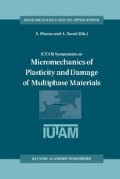Abstract
Zirconium, a material principally used in the nuclear industry, is characterized by the existence of two allotropic varieties, the ß phase and the α phase which are b.c.c and h.c.p crystals respectively. The former is found above 1138K and the later below the same critical temperature. The microstructure arises from a bainitic transformation of the ß phase into the α phase. It consists in colonies composed of parallel laths with the same crystallographic orientation; the “lath boundaries” are the planes where the precipitates of betagenic elements (Fe, Cr, Ni) lie. The principal deformation mechanism under uniaxial tension is prismatic slip: three prismatic slip systems <112̄0> (101̄0) can be activated.
Access this chapter
Tax calculation will be finalised at checkout
Purchases are for personal use only
Preview
Unable to display preview. Download preview PDF.
References
Spurrier, J. and Scully, J.C. (1972) Fratographic aspects of the stress corrosion cracking of Titanium in a methanol/HCl mixture, Corrosion-NACE 28, 12, 453–463.
Atchinson, I. and Cox, B. (1972) Interpretation of fractographs of SCC in hexagonal metals, technical note, Corrosion-NACE 28, 3, 83–87.
McClintock, F.A.,(1968) J. Appl. Mech. ASME 35, 363.
Timoschenko, S. (1961) Théorie de l’Élasticité, Ch. Béranger, Paris, Liège, pp. 80–81.
Neuman, P. (1974) The geometry of slip processes at a propagating fatigue crack-II, Acta. Met., 22, 117–1178.
Pelloux, R.M. (1969) Proc. Air Force Conf. on fatigue and fracture of aircraft. Structures and Materials, Miami Beach, p 409.
Lemoine, P., Forgeron, T., Le Naour, F., Marini, B. and Mottot, M. (1990) Propriétés mécaniques générales: spécificités du zirconium grade 702, Journées d’études sur le zirconium, pp 75–91.
Author information
Authors and Affiliations
Editor information
Editors and Affiliations
Rights and permissions
Copyright information
© 1996 Kluwer Academic Publishers
About this paper
Cite this paper
Crepin, J., Bretheau, T. (1996). Crystallographic Growth of Cavities in Zirconium. In: Pineau, A., Zaoui, A. (eds) IUTAM Symposium on Micromechanics of Plasticity and Damage of Multiphase Materials. Solid Mechanics and its Applications, vol 46. Springer, Dordrecht. https://doi.org/10.1007/978-94-009-1756-9_23
Download citation
DOI: https://doi.org/10.1007/978-94-009-1756-9_23
Publisher Name: Springer, Dordrecht
Print ISBN: 978-94-010-7285-4
Online ISBN: 978-94-009-1756-9
eBook Packages: Springer Book Archive

